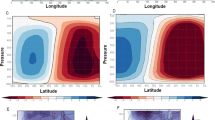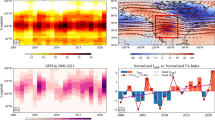Abstract
Prediction of Indian summer (June–September) rainfall on regional scales remains an open issue. The operational predictions of West Central Indian summer rainfall (WCI-R) and Peninsular Indian summer rainfall (PI-R) made by the Indian Meteorological Department (IMD) had no skills during 2004–2012. This motivates the present study aiming at better understanding the predictability sources and physical processes governing summer rainfall variability over these two regions. Analysis of 133 year data reveal that although the lower boundary forcing that associated with enhanced WCI-R and PI-R featured a similar developing La-Nina and “east high west low” sea-level pressure (SLP) dipole pattern across the Indo-Pacific, the anomalous high sea surface temperature (SST) over the northern Indian Ocean and weak low pressure over northern Asia tended to enhance PI-R but reduce WCI-R. Based on our understanding of physical linkages with the predictands, we selected four and two causative predictors for predictions of the WCI-R and PI-R, respectively. The intensified summer WCI-R is preceded by (a) Indian Ocean zonal dipole-like SST tendency (west-warming and east-cooling), (b) tropical Pacific zonal dipole SST tendency (west-warming and east-cooling), (c) central Pacific meridional dipole SST tendency (north-cooling and south-warming), and (d) decreasing SLP tendency over northern Asia in the previous season. The enhanced PI-R was lead by the central-eastern Pacific cooling and 2-m temperature cooling tendency east of Lake Balkhash in the previous seasons. These causative processes linking the predictors and WCI-R and PI-R are supported by ensemble numerical experiments using a coupled climate model. For the period of 1871–2012, the physics-based empirical (P-E) prediction models built on these predictors result in cross-validated forecast temporal correlation coefficient skills of 0.55 and 0.47 for WCI-R and PI-R, respectively. The independent forecast skill is significantly higher than the skill of operational seasonal forecast made by the IMD for the period of 2004–2012. These prediction models offer a tool for seasonal prediction and their retrospective forecast skills provide an estimation of the lower bound of the predictability for WCI-R and PI-R.










Similar content being viewed by others
References
Abdi H (2010) Partial least squares regression and projection on latent structure regression (PLS regression). Wiley Interdiscip Rev: Comp Stat 2:97–106
Ashok K, Guan Z, Yamagata T (2001) Impact of the Indian Ocean dipole on the relationship between the Indian monsoon rainfall and ENSO. Geophys Res Lett 28:4499–4502
Ashok K et al (2004) Individual and combined influences of ENSO and the Indian Ocean Dipole on the Indian summer monsoon. J Clim 17:3141–3155
Bagla P (2006) Controversial Rivers Project aims to turn India’s fierce monsoon into a friend. Science 313:1036–1037
Bamzai AS, Shukla J (1999) Relation between Eurasian snow cover, snow depth, and the Indian Summer monsoon: an observational study. J Clim 12:3117–3132
Blockeel H, Struyf J (2003) Efficient algorithms for decision tree cross-validation. J Mach Learn Res 3:621–650
Cao J et al (2015) Major modes of short-term climate variability in the newly developed NUIST Earth System Model (NESM). Adv Atmos Sci 32:585–600
Chang CP, Harr P, Ju J (2001) Possible roles of Atlantic circulations on the weakening Indian monsoon rainfall–ENSO relationship. J Clim 14:2376–2380
Charney JG, Shukla J (1981) Predictability of monsoons. In: Monsoon dynamics. Cambridge University Press, Cambridge
Cherchi A, Navarra A (2013) Influence of ENSO and of the Indian Ocean Dipole on the Indian summer monsoon variability. Clim Dyn 41:81–103
Compo GP et al (2011) The twentieth century reanalysis project. Q J R Meteor Soc 137:1–28
DelSole T, Shukla J (2009) Artificial skill due to predictor screening. J Clim 22:331–345
Gadgil S et al (2004) Extremes of the Indian summer monsoon rainfall, ENSO and equatorial Indian Ocean oscillation. Geophys Res Lett 31:L12213
Geisser S (1975) The predictive sample reuse method with applications. J Am Stat Assoc 70:320–328
Gill AE (1980) Some simple solutions for heat-induced tropical circulation. Q J R Meteor Soc 106:447–462
Hahn DG, Shukla J (1976) An apparent relationship between Eurasian snow cover and Indian monsoon rainfall. J Atmos Sci 33:2461–2462
Hoke JE, Anthes RA (1976) The initialization of numerical models by a dynamic-initialization technique. Mon Weather Rev 104:1551–1556
Hunke EC, Lipscomb WH (2010) CICE: the Los Alamos Sea ice model documentation and software user’s manual version 4.1. LA-CC-06-012. T-3 Fluid Dynamics Group, Los Alamos National Laboratory, Los Alamos
Ihara C et al (2007) Indian summer monsoon rainfall and its link with ENSO and Indian Ocean climate indices. Int J Climatol 27:179–187
Krishnamurthy V, Goswami BN (2000) Indian monsoon–ENSO relationship on interdecadal timescale. J Clim 13:579–595
Kumar KK, Rajagopalan B, Cane MA (1999) On the weakening relationship between the Indian monsoon and ENSO. Science 284:2156–2159
Kumar KK et al (2006) Unraveling the mystery of Indian monsoon failure during El Niño. Science 314:115–119
Lee J-Y et al (2011) How predictable is the northern hemisphere summer upper-tropospheric circulation? Clim Dyn 37:1189–1203
Lee J-Y et al (2013) Seasonal prediction and predictability of the Asian winter temperature variability. Clim Dyn 41:573–587
Li J, Wang B (2016) How predictable is the anomaly pattern of the Indian summer rainfall? Clim Dyn 46:2847–2861
Madec G (2008) NEMO ocean engine, Note du Pole de modélisation, Institut Pierre-Simon Laplace (IPSL), NO 27, ISSN No 1288-1619, France
Murphy AH (1988) Skill scores based on the mean square error and their relationships to the correlation coefficient. Mon Weather Rev 116:2417–2424
Parthasarathy B, Kumar KR, Munot AA (1993) Homogeneous Indian monsoon rainfall: variability and prediction. Proc Indian Acad Sci Earth Planet Sci 102:121–155
Parthasarathy B, Munot AA, Kothwale D (1995) Monthly and seasonal rainfall series for All-India Homogeneous Regions and Meteorological Subdivision: 1871–1994. RR-065, Indian Institute of Tropical Meterology, Pune
Peings Y, Douville H (2009) Influence of the Eurasian snow cover on the Indian summer monsoon variability in observed climatologies and CMIP3 simulations. Clim Dyn 34:643–660
Rajeevan M, Guhathakurta P, Thapliyal V (2000) New models for long range forecasts of summer monsoon rainfall over North West and Peninsular India. Meteorol Atmos Phys 73:211–225
Rajeevan M et al (2007) New statistical models for long-range forecasting of southwest monsoon rainfall over India. Clim Dyn 28:813–828
Rajeevan M, Unnikrishnan CK, Preethi B (2012) Evaluation of the ENSEMBLES multi-model seasonal forecasts of Indian summer monsoon variability. Clim Dyn 38:2257–2274
Rasmusson EM, Carpenter TH (1982) Variations in tropical sea surface temperature and surface wind fields associated with the southern oscillation/El Niño. Mon Weather Rev 110:354–384
Roeckner E et al (1996) The atmospheric general circulation model ECHAM4: Model description and simulation of the present-day climate. MPI für Meteorologie, Hamburg
Saji NH et al (1999) A dipole mode in the tropical Indian Ocean. Nature 401:360–363
Shukla J (1987) Inter-annual variability of monsoons. In: Fein JS, Stephens PL (eds) Monsoon, pp 523–548
Shukla J, Mooley DA (1987) Empirical prediction of the summer monsoon rainfall over India. Mon Weather Rev 115:695–704
Shukla J, Paolino DA (1983) The southern oscillation and long-range forecasting of the summer monsoon rainfall over India. Mon Weather Rev 111:1830–1837
Smith TM et al (2008) Improvements to NOAA’s historical merged land-ocean surface temperature analysis (1880–2006). J Clim 21:2283–2296
Smith TM et al (2010) Merged statistical analyses of historical monthly precipitation anomalies beginning 1900. J Clim 23:5755–5770
Smoliak BV et al (2010) Application of partial least squares regression to the diagnosis of year-to-year variations in Pacific Northwest snowpack and Atlantic hurricanes. Geophys Res Lett 37:L03801
Vernekar AD, Zhou J, Shukla J (1995) The effect of Eurasian snow cover on the Indian monsoon. J Clim 8:248–266
Wang B, Xie X (1996) Low-frequency equatorial waves in vertically sheared zonal flow. Part I: stable waves. J Atmos Sci 53:449–467
Wang B, Wu R, Lau K (2001) Interannual variability of the Asian summer monsoon: contrasts between the Indian and the Western North Pacific-East Asian monsoons. J Clim 14:4073–4090
Wang B, Wu R, Li T (2003) Atmosphere–warm ocean interaction and its impacts on Asian–Australian monsoon variation. J Clim 16:1195–1211
Wang B et al (2015) Rethinking Indian monsoon rainfall prediction in the context of recent global warming. Nat Commun 6:7154
Webster PJ, Yang S (1992) Monsoon and ENSO: selectively interactive systems. Q J R Meteor Soc 118:877–926
Webster PJ et al (1998) Monsoons: processes, predictability, and the prospects for prediction. J Geophys Res 103:14451–14510
WMO (2002) Standardised verification system for longrange forecasts (LRF): new attachment II-9 to the manual on the GDPS. WMO No. 485, WMO, Geneva
Wu R, Chen J, Chen W (2011) Different types of ENSO influences on the Indian summer monsoon variability. J Clim 25:903–920
Xie X, Wang B (1996) Low-frequency equatorial waves in vertically sheared zonal flow. Part II: unstable waves. J Atmos Sci 53:3589–3605
Xing W, Wang B, Yim S-Y (2014) Peak-summer East Asian rainfall predictability and prediction part I: Southeast Asia. Clim Dyn. doi:10.1007/s00382-014-2385-0
Yim S-Y, Wang B, Xing W (2014) Prediction of early summer rainfall over South China by a physical-empirical model. Clim Dyn 43:1883–1891
Yim S-Y, Wang B, Xing W (2015) Peak-summer East Asian rainfall predictability and prediction part II: extratropical East Asia. Clim Dyn. doi:10.1007/s00382-015-2849-x
Acknowledgments
This study is supported by the Atmosphere–Ocean Research Center (AORC) and IPRC at University of Hawaii and the National Research Foundation (NRF) of Korea through a Global Research Laboratory (GRL) grant of the Korean Ministry of Education, Science and Technology (MEST, #2011-0021927). The AORC is partially funded by Nanjing University of Information Science and Technology (NUIST). This is the NUIST-Earth System Modeling Center (ESMC) publication number 116, the SOEST publication number 9642, the IPRC publication number 1199.
Author information
Authors and Affiliations
Corresponding author
Rights and permissions
About this article
Cite this article
Li, J., Wang, B. & Yang, YM. Retrospective seasonal prediction of summer monsoon rainfall over West Central and Peninsular India in the past 142 years. Clim Dyn 48, 2581–2596 (2017). https://doi.org/10.1007/s00382-016-3225-1
Received:
Accepted:
Published:
Issue Date:
DOI: https://doi.org/10.1007/s00382-016-3225-1




